2025 McLaren Artura Spider Is the One to Be Seen In
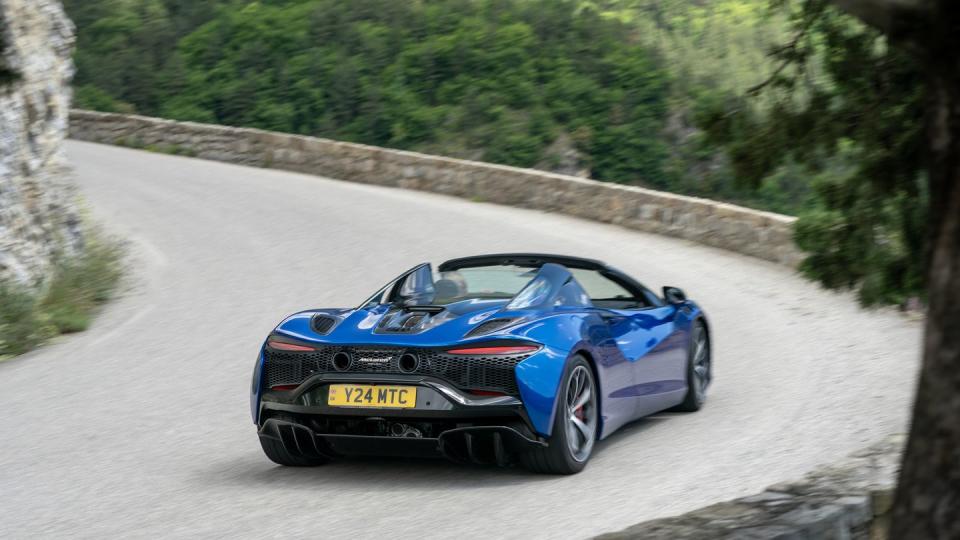
If there was one disappointing thing about pulling up to Monaco's Hôtel de Paris in a McLaren Artura Spider, it's that the venue was not at that moment hosting your author's high-school reunion. After all, the next best thing to driving a supercar is being seen driving a supercar, which is why the Artura Spider follows the launch of the Artura coupe as inevitably as Tuesday follows Monday. It's also why McLaren expects the Spider to comprise more than half of Artura sales.
And why not? The Spider gives away nothing to the coupe in terms of head-turning looks or the heady driving experience.
McLaren claims the Spider is only 136 pounds heavier than the coupe, the last of which we weighed tipped our scales at 3443 pounds. And the carbon-fiber tub at the core of the Artura requires no reinforcements for convertible duty. For those reasons, the Spider's chassis tuning is no different from the coupe's.
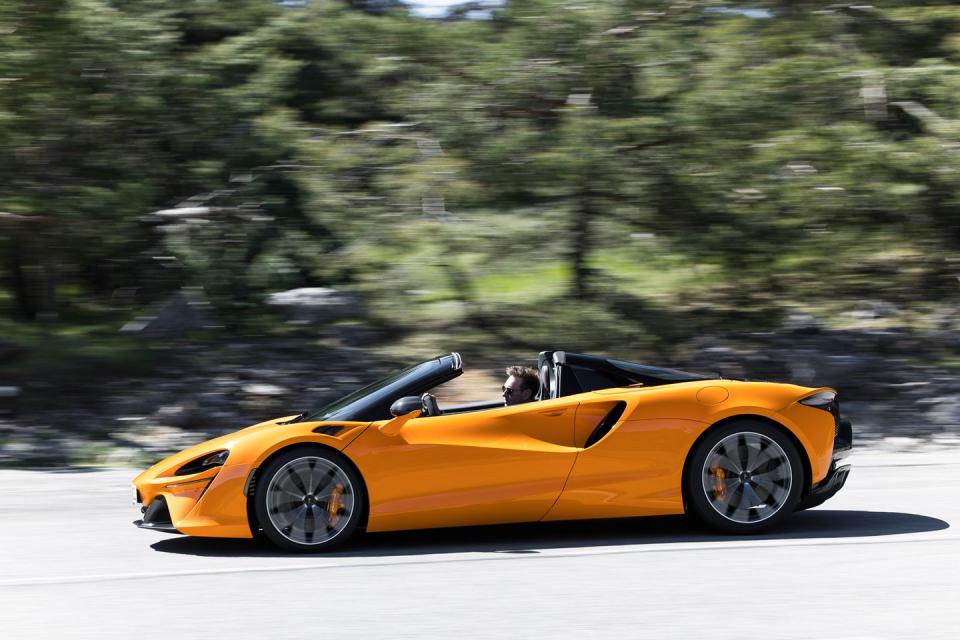
The Artura has a plug-in-hybrid powertrain, its V-6 engine a departure from the V-8s that have powered the brand's modern-day road cars. Smaller and lighter than McLaren's preceding motivators, the dry-sump 3.0-liter unit has its twin turbochargers nestled within the engine's V for quicker response, and a 7.4-kWh battery powers a 94-hp motor tucked within the eight-speed dual-clutch transmission's bellhousing. All told, the powertrain produces a combined 691 horsepower and 531 pound-feet of torque. That horsepower number is 20 more than in last year's coupe, courtesy of recalibrations to the gas engine, and the 2025 coupe gets the same output (in fact, current Artura owners can have their cars upgraded to the full 691-hp spec for free at the dealership).
McLaren says the Spider matches the coupe's 60-mph time, which the company puts at 3.0 seconds. The top-speed claims are also identical at 205 mph. In our previous testing, the Artura coupe (with its mere 671 horses) hit 60 mph in 2.6 seconds and rocketed to 100 mph in 5.5 seconds. There's a launch control system if you're looking to match those times, but if you'd rather put on a bit of a show, there's a new Spinning Wheel Pull-Away mode—that's genteel British for "burnout mode."
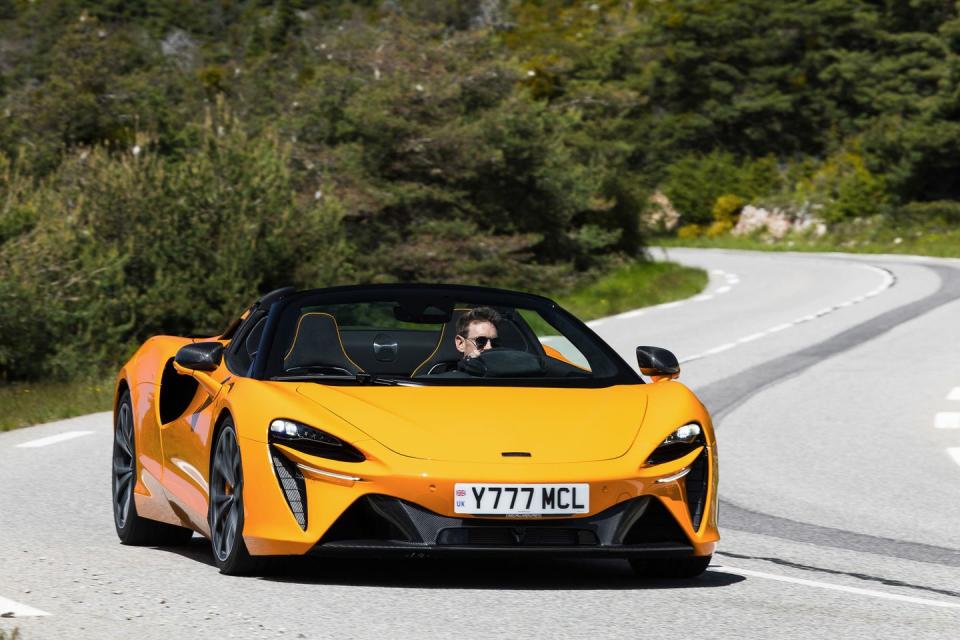
The uptick in engine output is just one area in which the Spider introduces revisions that spread this year to the coupe as well. Others include stiffer powertrain mounts, a faster-shifting eight-speed dual-clutch gearbox, and adaptive dampers with both revised internals and quicker response rates.
McLaren wrings the Artura's extra horsepower from the engine in the upper part of the rev range, and it's a thrill to wind this engine out toward its 8200-rpm redline. Pressing the accelerator deep into its long travel blurs the scenery in short order; hold it there, and the car continues to race ahead. You'll need wide open spaces to truly exercise the Artura, and luckily that's what we had on our drive, which encompassed part of the Route Napoleon in southern France.
The powertrain modes are Comfort, Sport, Track, and electric-only E-mode. Sport and Track keep the engine on, and both will keep the battery sufficiently charged so that it's always able to lend a helping hand when called upon. Comfort will switch the engine off under light load, and E-mode locks in near-silent battery-powered cruising for creeping through city centers. While that's mostly a low-speed use case, E-mode mode is good to 81 mph, and McLaren says the Spider achieves the same 11 miles of emissions-free range as the coupe on of a fully charged battery.

McLaren has revised the Artura's exhaust system for the Spider, seeking a sportier sound. Both the standard exhaust and the upgraded sport exhaust feature active valves, but the optional sport setup sends engine sound waves directly to the cabin. Even with it, the V-6 doesn't sing like the brand's V-8.
For all the new powertrain thinking, the Artura retains electrohydraulic steering assist, which is deliciously full of feel and unerringly accurate. We also loved the fact that it doesn't vary in assist or ratio, nor is it altered by the drive modes. The faithful helm invites you to put the sophisticated chassis to work, and on the numerous switchbacks that take you from the Mediterranean coast up to the interior highlands, the Artura delivered incredible turn-in response and a terrific sense of balance that lives up to the bodywork's promise of Olympic athleticism—this despite the fact that the Artura doesn't have the hydraulically cross-linked suspension of the 750S, instead using coil springs and adaptive dampers. McLaren avoids drive mode overload with just three chassis settings: Comfort, Sport, and Track. Track makes you aware of every pebble in the road surface, but the other two deliver an entirely civilized ride over pavement imperfections while also maintaining tight control of body motions. When we had the Artura coupe out at our test track, it suctioned itself to the tarmac with 1.08 g's, and we'd expect similar numbers from the Spider, which wears staggered-size Pirelli P Zero summer tires, sized 235/35ZR-19 in front and 295/35ZR-20 at the rear.
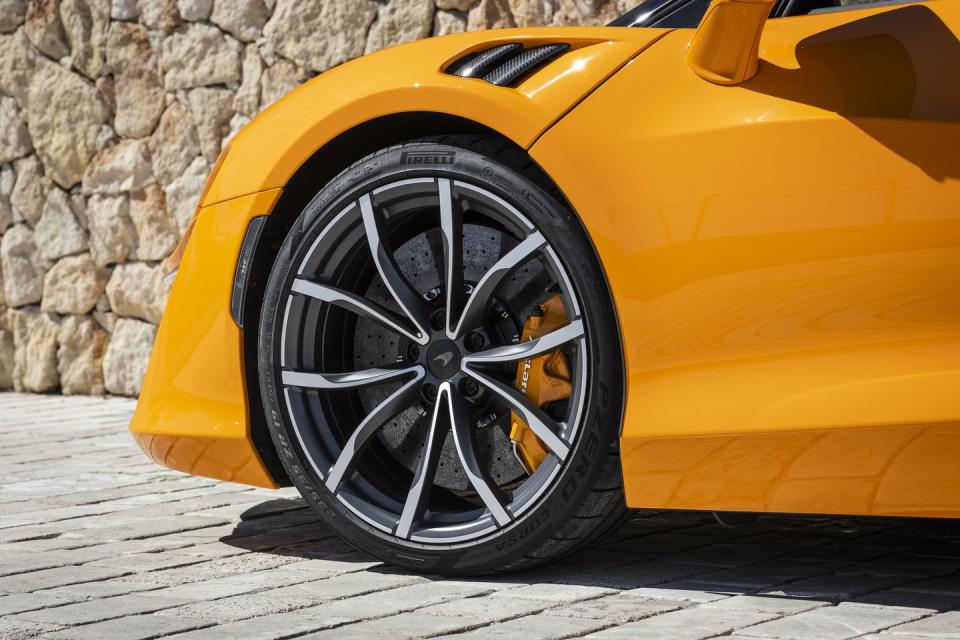
Bringing everything to heel is a braking system with carbon-ceramic rotors that, in our testing, hauled the coupe to a stop from 70 mph in 141 feet. The ABS calibration has been revised for 2025, however, which could bring slightly better results. Even though this is a hybrid, there's no lift-off regen, and the brake pedal, which responds more to pressure than to travel, actuates the friction brakes only, so there's no awkward transition in pedal feet. There's also no squealing at in-town speeds, a common issue with carbon-ceramic stoppers. The pedal box is tight however. The left footrest is close to the brake pedal, and those with large feet may toe the underside of the dash when coming off the brake pedal.
Lifting the lid on the Artura is an 11-second operation, as the roof panel (either a solid carbon-fiber composite unit or an optional one with electrochromic glass) motors up and backward to tuck under a rear-hinged carbon-fiber tonneau cover. The rear glass can be independently powered up and down; raise it when the roof is stowed to reduce in-cabin wind buffeting or lower it when the top is up to allow more engine sound into the cabin.
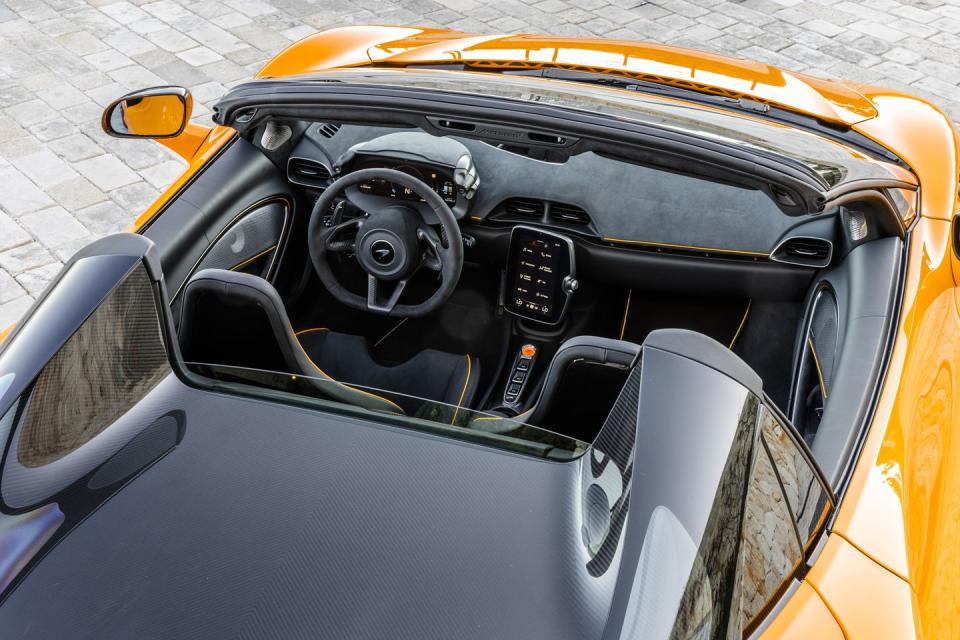
The Artura cabin is far forward, in the classic supercar style, and the cowl is low, which helps the driver accurately place the car on the road. The Spider's rear buttresses, which channel air flow, are partially clear plastic, helping rear visibility a bit. Still, we'd pony up for optional blind-spot monitoring, which is bundled with rear cross-traffic detection, adaptive cruise, and auto high-beams in the $8350 Driving Assistant pack. We'd also want the 360-degree-view camera, part of the $7400 Technology Pack that also brings a Bower & Wilkins 12-speaker audio system, wireless smartphone charging, and LED headlights. Lane-departure warning and traffic-sign recognition are newly standard.
In the U.S. market, the standard fitment includes Clubsport seats with optional power lumbar support, and those chairs are firmly padded but wide enough to fit most body types. The lighter-weight choice, they have manual fore-aft adjustment and a power adjustment that moves the whole seat—cushion and backrest—together in an arc: from higher and more upright to lower and more reclined. Alternately, no-cost-option Comfort seats have standard-style 10-way power adjustment and heating (which is not available on the Clubsport seats). Both have a pouch at the front edge of the cushion that serves as a place to stash the key fob.
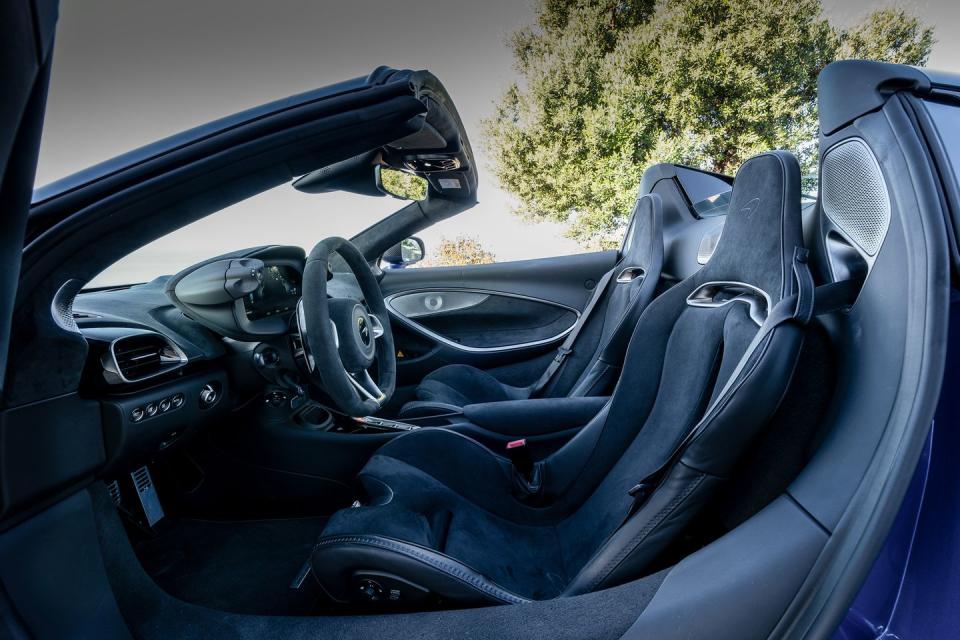
As in the coupe, the instrument binnacle moves with the adjustable steering column, ensuring its visibility. Little flippers to select the powertrain and chassis modes are set into the edge of the binnacle's hood and are ergonomic perfection. They're within easy reach of an outstretched finger without taking one's hand off the wheel, and their operation is intuitive: Flip up for the next sportier mode and flip down for the reverse. The left one controls damping modes, the right does the powertrain. Each also has a button in the middle: ESC off (on the left) and manual shift mode (on the right). The setup is easier than buttons on the center console and far superior to any on-screen solution.
McLaren, laudably, maintains physical controls for much of this car's switchgear and really makes an effort to keep a separation of function. Once you learn the layout, it's quite user-friendly. The toggles to operate the roof and the power rear window, for instance, are up on the windshield header near the roof. And it's a quick stab for the button that raises and lowers the ride height—a front-axle lift system is standard in the States—perfect for all the speed humps that pop up in the towns along the Côte d'Azur.
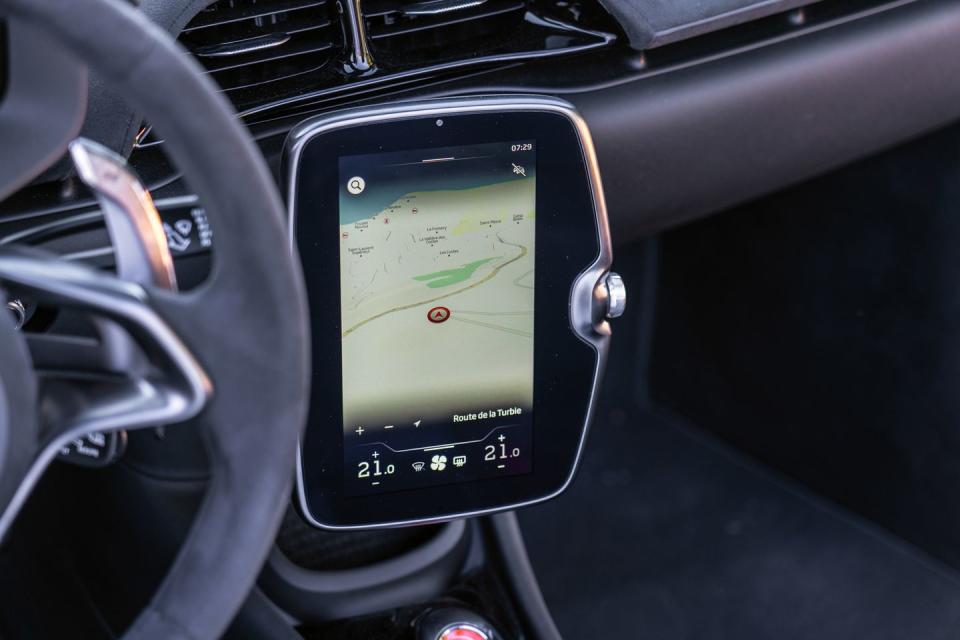
The 8.0-inch infotainment display is on the small side, but you don't interact with it all that much. Apple CarPlay is supported, but Android Auto is not. The optional wireless smartphone charger snugly holds your phone in an upright position—although it sacrifices one of the two cupholders.
The Spider is every bit the supercar that its coupe counterpart is. The one downside is cost: At a starting price of $281,008, the Spider is $24,700 dearer than its fixed-roof sibling. But we imagine that additional outlay is not much more than a speed bump to McLaren shoppers, many of whom already have multiple supercars. And if you've got it, may as well flaunt it. Particularly if you have a class reunion coming up.
You Might Also Like

 Yahoo Autos
Yahoo Autos 